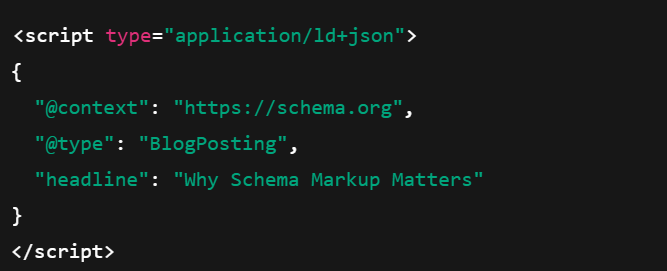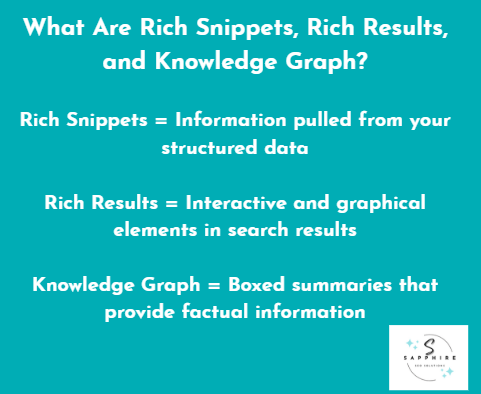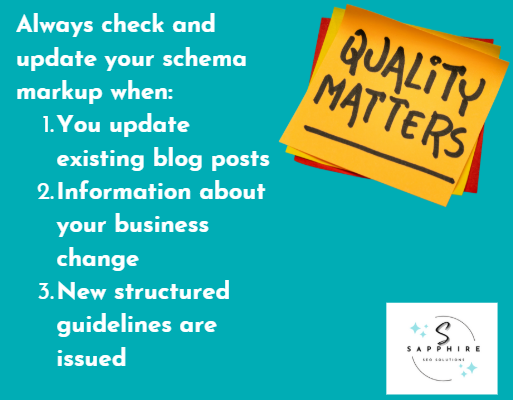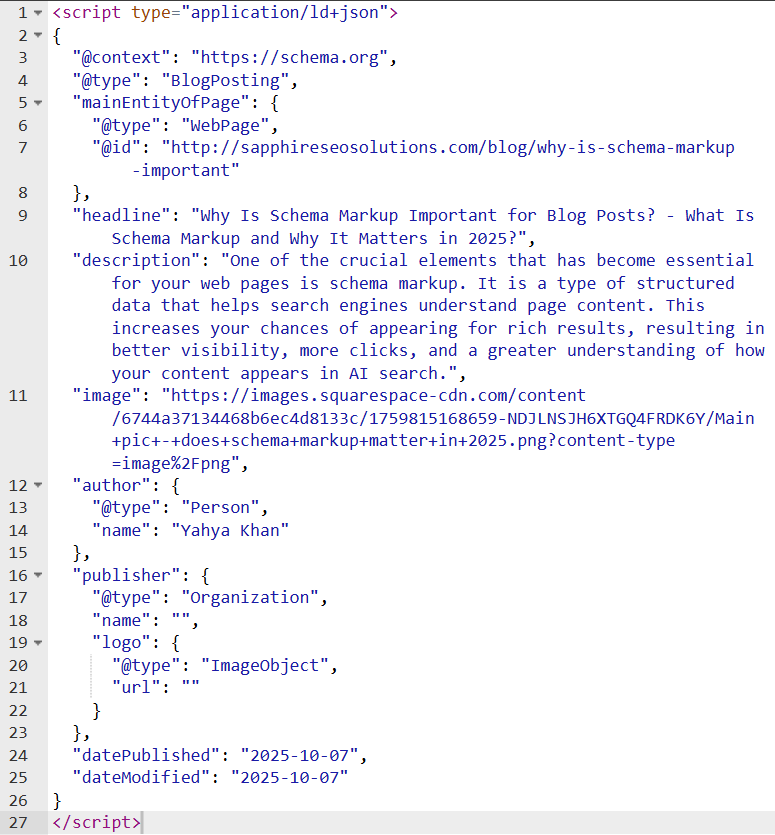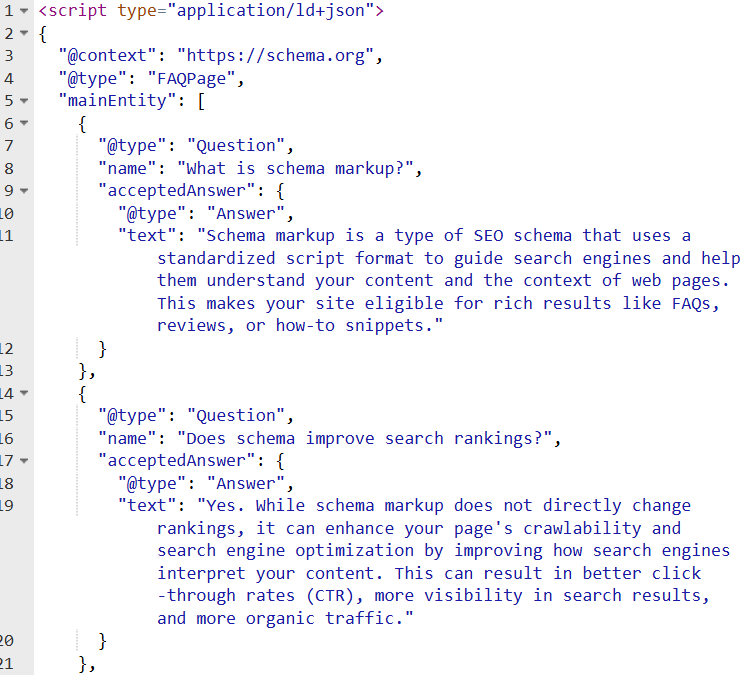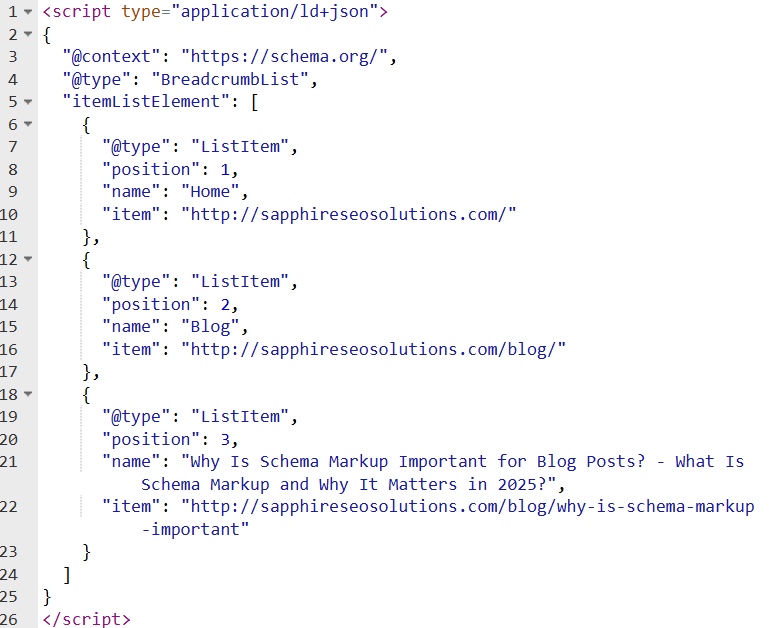Why Is Schema Markup Important for Blog Posts? - What Is Schema Markup and Why It Matters in 2025?
SEO has evolved, and signals that weren't that important before can now make or break your website. One of the crucial elements that has become essential for your web pages is schema markup. It is a type of structured data that helps search engines understand page content. This increases your chances of appearing for rich results, resulting in better visibility, more clicks, and a greater understanding of how your content appears in AI search.
Why has schema markup all of a sudden taken center stage? Traditional search engine optimization (SEO) focused on keywords to understand the context of a page. However, now that it's all about AI-powered search and voice results, schema markup has become important for SEO due to the following reasons:
It increases eligibility for rich results and rich snippets. This provides blog posts with an enhanced display in the search engine results pages (SERPs).
It displays relevant content to users and makes results more visually appealing. This boosts click-through rates (CTR).
It assists AI search engines in understanding the content and context of your web pages.
Key Takeaways
Schema markup makes your blog posts AI-search-ready and boosts visibility through rich results.
It helps search engines understand your content context, improving how your pages appear in SERPs and AI Overviews.
Implementing schema using JSON-LD aligns with Google’s best practices and reinforces E-E-A-T credibility.
Validate and update schema regularly to stay compliant, enhance CTR, and secure AI-driven placements.
Schema markup is an essential technical SEO element that can have a positive impact on your site if executed correctly. At Sapphire SEO Solutions, our technical SEO experts have created a checklist that we follow for each client, ensuring that their sites are compliant with the latest and best SEO practices.
We create schema markups for every page we work on, increasing your chances of ranking higher in traditional search engines and attracting AI search engines as well.
Since schema markup can be a technical topic to tackle, we've created this detailed guide to walk you through what it is, its benefits, and what you should avoid.
Keep reading until the end, as we will answer some of your most pressing questions in regards to structured data items.
Let's get started!
What is Schema Markup?
Ever heard of semantic markup (semantic HTML)? It uses HTML elements to convey the meaning of the content it contains. Schema markup is a type of semantic markup that provides search engines with the context of your web content.
Sounds confusing, right? Don't worry, as we will explain everything as you gradually read through this guide.
Search engines can crawl through your page to read what the content is about. But it needs information to determine context and intent and identify authoritative signals. These are all important for attracting the attention of AI search engines. Schema markup provides all of this and more.
In 2011, major search engines like Google, Bing, and Yandex, among others, worked together on a project known as Schema.org (https://schema.org).
The result? These big companies created a standardized format for structured data on web pages so that search engines can understand the information properly and display it accurately in search results.
Simply put, schema markup is a structured data markup layer. It translates your content into a language that search engines and AI tools can interpret more accurately.
Many business owners think of schema markup as a technical upgrade. They consider it as optional, when in reality, it's the only way to get your blog posts noticed in a crowded space.
Is Schema Markup the Same as Structured Data?
There is a common misconception that schema markup and structured data are the same. But they are not.
Schema.org is an online semantic markup vocabulary that defines what types of information exist. They may include details like author, data, FAQ, reviews, and more.
On the other hand, structured data markup refers to the way developers actually implement the semantic markup vocabulary in a standardized format. This is usually done within a website's HTML code.
Is this information too technical to understand? Let's further simplify this.
Schema markup = vocabulary
Structured data = implementation
What Are the Different Schema Markup Formats?
To use structured data across your webpages, there are three main schema encoding types, which include JSON-LD, Microdata, and RDFa.
JSON-LD, short for JavaScript Object Notation for Linked Data, is a highly recommended schema format. It's implemented via a JSON-LD script in the page’s <head> or <body>. This format reduces clutter in your in-page markup and keeps your HTML tag attributes clean.
The following screenshot is how a JSON-LD script should look:
Now that you know a bit more about the JSON-LD format, what about the other two?
Microdata embeds schema directly into your HTML with tag attributes. This makes it super hard to maintain the code, especially when scaling the site. On the other hand, RDFa is more flexible than microdata, but it's not that common to use.
So, why has JSON-LD markup become the industry standard? Because it is cleaner, easier to manage, and doesn’t interfere with visible HTML code. That's why developers prefer it over other schema formats.
Who Maintains the Online Schema Vocabulary?
Schema.org, a collaborative project by many large search engines, maintains the online schema vocabulary. The website releases regular updates to reflect the changes in how people search and share information online.
What are these structured data guidelines for? They are there to ensure that developers and marketers use schema correctly, especially when schema types continue to evolve.
Does Schema Terminology Matter to Search Engines?
To know whether schema terminology matters to search engines, you need to know what schema is about. In simple words, schema helps search engines understand your content more accurately.
When readers read through your blog, the plain text allows them to learn what it is about. Search engines work in a different way, which is why they need schema to understand your content.
With schema markup, you can feed Google Search and other search engines metadata about your blog post. This is better than letting search engines do all of the guesswork, which can be inaccurate most of the time.
Metadata, such as title or author, feeds into the search engines like the knowledge graph and linked data models. This helps the content appear not only in rich snippets but also in AI-driven summaries, chat results, and answer boxes. It bridges the gap between human-readable blogs and machine-readable intelligence.
How Does a Schema Markup Impact Rich Snippets and Rich Results?
Schema markup helps transform how your blog posts look in search engine results pages (SERPs). While it may be daunting to create effective schema markups, the results are well worth the effort, especially when your content starts appearing in rich snippets, rich results, or a knowledge graph. Let's explore these in detail.
What Are Rich Snippets, Rich Results, and Knowledge Panels?
Rich snippets are pieces of extra information pulled from structured data markup. They may include star ratings, event dates, or opening times. You'll often see this type of information directly in the search results.
Rich results are interactive or graphical elements in search results. They may include carousels, accordions, or FAQ markup dropdowns, and they are generated from structured data on your site.
Knowledge panels, powered by the knowledge graph, appear on the right-hand side of Google. They provide factual snapshots about brands, people, or entities. Simply put, they are boxed summaries of key information.
All of these can elevate your content and turn it into visually engaging, enhanced displays. These provide more opportunities for website owners and content marketers to feature in review snippets, FAQs, or featured media. They can help attract the users' attention.
Examples of Schema Markups
There are different types of schema markups that can help deliver a wide range of improvements to your page structure in search results. They include the following:
Review schema markup enables review snippets (star ratings, product feedback).
Breadcrumb schema clarifies your site’s hierarchy and helps users navigate easily.
FAQ markup generates dropdowns under your link that answer common reader questions.
VideoObject schema ensures your videos show rich video thumbnails.
Author details (name, photo), publication date, and even timeRequired or reading time notes can appear alongside your result.
Google search results are often filled with hundreds of pages. This can make it challenging to stand out and rise to the top. Fortunately, with schema markups, you can improve your page's visibility in the SERPs and also signal credibility to AI search engines.
Can Rich Results, Rich Snippets, and Knowledge Panels Boost CTR?
User-visible content is super important, as it makes your pages feel more authoritative. They include reviews, star ratings, or FAQs. When users see this type of content, they are more likely to click on your page. This leads to a clear CTR lift, resulting in a blog post that outperforms your competitors' content.
Schema markup turns ordinary listings into enhanced displays. A better visual presentation can boost trust, drive clicks, and improve engagement. This not only results in a CTR lift but also reinforces your content’s relevance in search engine results pages.
Why Should You Use Schema Markups? - The Benefits of Using Schema Markup
Schema markup is a strategic tool that connects the following elements together:
Search engine optimization (SEO)
User experience (UX)
The principles of E-E-A-T (Experience, Expertise, Authoritativeness, Trustworthiness)
Having the right schema can improve your blog post's chances of:
Appearing in AI search results
Experiencing an increase in CTR
Building credibility with users and big search engines
The following are some of the benefits of using schema markup:
It Has a Direct Correlation to CTR
Does schema markup have an impact on CTR? Absolutely! But how?
Several studies show that SEO schema can improve organic traffic. Listings with the following rich elements can help your blog posts stand out in the SERPs:
Relevant keywords
Star ratings
FAQs
There are many case studies that highlight the impact of schema markup on CTR. For example, a local restaurant implemented the Local Business schema. It included many relevant details like the menu, operating hours, and location. Doing so made it easier for potential customers to find the establishment in search results. This resulted in a 50% increase in reservations for the restaurant.
It Establishes Topical Authority and E-E-A-T
Building trust and authority has become really important in the era of AI search engines. Why?
Because AI search engines use authoritative signals to determine whether a particular content is factual and credible to be used in AI-generated answers. This is why you should focus on implementing the Author schema and the Person schema wherever possible.
You need to tell Google that you're experienced and trustworthy, and these two types of schema markups do just that. Think of it as spoon-feeding search engines with relevant information about your posts.
The Author and the Person schema feed into the knowledge graph, allowing your content to appear in fact panels or other authoritative placements.
If you're a local business, you should focus on creating a strong semantic footprint that reinforces authority. Here's how you can do that:
By implementing the Local Business schema to strengthen visibility in Google Maps
By connecting schema markup to link all of the entities, including authors and organizations, together
Reinforcing authority is an essential part of E-E-A-T. Check out our blog on "What is E-E-A-T?" to learn more about these Google guidelines and how they can impact your site's SEO.
It Eliminates Ambiguity
Whether you're writing a service page or publishing an informational blog, you need to maintain clarity.
For example, without any context, Google and other search engines may think of "Apple" as a fruit instead of the tech giant. Schema markup provides the semantic markup needed for accurate entity recognition.
Relevant schema types and linked data can provide Google and other search engines with explicit clues to guide them to the entity your page refers to. This ensures that your content is:
Properly categorized
Not misinterpreted
Ready to improve visibility in queries
It Helps with AI Overviews
AI Overviews has shaken up the world of SEO. It's affected how users search for information, products, or services. By browsing the internet, AI search engines can intelligently display relevant content in their answers.
While AI Overviews is making it easier for users, it's adversely impacting sites. Perhaps this is why you may be experiencing a dip in traffic. This has given rise to AI SEO or Generative Engine Optimization, which, if you ask us, is the future of search engine optimization.
Are you experiencing lost traffic? Do you want to gain visibility? Update existing content and use a relevant schema markup on every page. Doing so makes it easy for AI or big search engines to parse webpages.
Structured data provides search engines with context. By embedding them in your site, you can increase the chances of being cited in AI-generated summaries. It's not about keyword research or rankings. Now, it's all about being authoritative and sounding credible.
Schema and the Future of SEO
A schema markup used to be about featuring in rich snippets. However, in 2025, it's become more than that. Structured data is now about:
Powering AI Overviews
Preparing for the semantic search
Fueling voice assistants
Delivering content into API feeds
If you want to future-proof your blog and other webpages, schema must be implemented correctly. You need to make sure that it aligns with structured data guidelines, and you must update it whenever required.
How Generative Search Prioritizes Structured Data
Generative search loves trustworthy information that provides value. When you search for something on Google, AI Overviews pulls pages that have well-formed, structured data items because it understands these webpages better than those with just text. Machine-readable context is great for reducing ambiguity.
Suppose you're a seasoned marketer with interviews all over the internet. When you write a post on a topic of your expertise and ensure the right schema markup, search engines know that information is credible. It will consider you as authoritative and credible due to the interviews you've done.
Preparing for Semantic Search and Stronger Knowledge Graph Connections
Semantic is the future of search. Search engines rely on semantic markup to understand:
Intent
The relationship between different entities
Recently, advancements in AI systems have made AI search engines more intelligent. They now focus on other aspects of content than keyword research. What does this mean for your business?
While traditional SEO is still relevant (it helps you rank higher in the SERPs), it won't help your site appear in AI-generated summaries. So, what should you do?
Today, it's all about guiding search engines better. At Sapphire SEO Solutions, we like to use entity linking while implementing the sameAs property in schema. This is a great way to connect blog posts to authoritative references like Wikipedia or LinkedIn.
The result? It strengthens your site’s presence in the knowledge graph.
What should you do? Use structured data with connected schema markup across your site to help link the following entities together:
Authors
Organizations
Blog posts
So, what happens when you use structured data with connected schema markup? Creating this web of relationships ensures that your blog post shows up in broader semantic search ecosystems.
Why is the FAQPage and HowTo Schema Important for Your Site's SEO?
As more and more users turn to AI assistants like Siri, Alexa, and Google Assistant for quick answers, voice search is becoming more common than ever before.
Businesses that want to appear in search results provided by AI assistants need to consider using a different type of schema. They include FAQ markup and the HowTo schema. Doing so allows AI assistants to extract user-visible content in a structured way. This approach makes it easy to deliver concise answers that align with search intent.
Does structured content guide API feeds? Yes, it allows third-party tools and chatbots to pull answers directly from your web pages. Whether you're publishing an informative blog or a comprehensive guide, structured content helps your webpage integrate into the AI assistant ecosystems.
Why Does Schema Quality Matter?
While schema markup is super important for your website, simply adding it to your content isn't enough. But why is that?
Search engines evaluate the schema markup for accuracy, completeness, and freshness. If your schema markup has outdated information, it can hurt your site's visibility.
Fixing schema markup issues as soon as possible is crucial for site owners. You need to revisit your old blog posts and update the schemas (where necessary) to ensure that these pages start performing once again.
For detailed information on refreshing existing content, make sure to read our comprehensive guide on "Content Refresh Strategy - How Updating Old Blogs Boosts SEO Fast."
What Are the Important Schema Types for Blog Posts?
Want to appear in AI search results? Focus on choosing the right schema encoding type. Following structured data guidelines can help with that.
There are many different types of schema, each serving a unique purpose. Keep in mind that one blog post may have multiple schemas. Using them together can help search engines:
Understand your page content
Display rich features
Establish trust signals for AI Overviews
Let's quickly discuss some of the most important schema markups that you should consider.
BlogPosting/Article Schema (Super Important)
A BlogPosting schema is super important for blogs. But if you're publishing a press release or a news article, you need to consider other options, which may include Article schema and NewsArticle.
One look at the schema code and you'll be running for the hills. This is because, for non-developers, looking at code can be daunting. It may not be your domain. But that's okay.
If you don't know what to do with a BlogPosting schema, we recommend providing at least the following information:
Headline
Description
Image
DatePublished
DateModified
Author
MainEntityOfPage.
Webpage schema is also a great option to consider. It helps search engines interpret your blog post within the broader site structure.
In addition to that, make sure to include keywords/topics within schema properties. They can help match with semantic relevance. Properly defining page content in a schema makes your page visible across search engines and AI-driven summaries.
Author (This is Great for E-E-A-T)
To boost your post's trustworthiness and credibility so that it attracts AI search engines, you should consider implementing the Author schema. This is also referred to as the Person schema. You don't need to fill out all of the details, but make sure to include the:
Author's name
URL
Job title
A great way to help search engines connect the writer with their verified social profile (LinkedIn) is to combine the Author schema with the sameAs property. It lets search engines confirm your identity, and the user-visible text strengthens E-E-A-T signals.
Organization
Your blog needs to be established as a published entity if you want to increase your chances of appearing in AI search results. A well-defined Organization schema can help with that.
Always include the following key information when creating this type of schema:
Organization’s name
Official logo
sameAs links to business profiles
Writing a blog about your company? Don't forget to include a Local Business schema. Doing so connects your online presence with your business's real-world identity. It's a fantastic way of boosting local SEO and increasing credibility in the eyes of Google Search and other search engines.
Navigation: BreadcrumbList
Crawlers crawl your website whenever you request indexing. But if your site doesn't have proper navigation, it can confuse these web spiders.
This is where a BreadcrumbList comes in. It's an easy-to-implement schema that defines how your page structure flows (starting from the homepage all the way to your blog post).
A Breadcrumbs schema provides search engines with an explicit hierarchy. It improves navigation features in SERPs.
Engagement & Q&A
Are you publishing blogs that offer tutorials, guides, or product reviews? Chances are, such blogs may contain interactive elements, which can make these posts easy to skim and more engaging.
However, depending on the type of interactive elements you use, you need to choose the right type of schema. Your options may include:
FAQ markup - This highlights common Q&As, enabling dropdown visibility in search results.
HowTo schema - This is ideal for step-based content like tutorials or DIY blogs.
VideoObject - This should be used when embedding videos to surface video thumbnails in results.
Review schema markup and AggregateRating - These can showcase review snippets, but should only be used when honest, transparent reviews exist.
How to Implement Schema Markup (And the Best Practices!)
When implemented correctly, a schema can be a powerful tool. That said, poor implementation can confuse search engines by providing incorrect or inaccurate information. This can prevent crawlers from crawling through your pages.
Schema markup issues can prevent your content from qualifying for rich results. Some of the most common ones include mistakes in:
Formatting
Placement
Maintenance
Need help implementing a schema? Here are some of the best practices:
JSON-LD is the Recommended Standard
While there are several formats for schema encoding types, including Microdata and RDFa, Google recommends the JSON-LD format. But why is that?
Google prefers JSON-LD, as this format keeps structured data separate from the visual HTML code. It’s much easier to manage, and there are no broken layouts.
JSON-LD script aligns with current SEO standards for structured data. This approach is also clean and modular.
Where to Place JSON-LD
When adding JSON-LD to your source code, Google and Bing support the following two placements:
The \<head> section
Before the closing \</body> tag
It's important to keep JSON-LD separate, as it ensures better clarity between presentation and structured data. Avoid embedding schema as inline Microdata tied to HTML elements or HTML tag attributes.
Types of Implementation Methods
The following are four ways of implementing schema markup:
Manual insertion: Add schema directly into templates. This gives you full control of the structured data. However, this method requires technical knowledge of writing schema markup and editing templates. Some business owners may not have that knowledge, which is why they should stay away from this implementation method.
WordPress plugins: Tools like Yoast, Rank Math, and Schema Pro make it easy to add schema markup to your pages. This is a simple way to implement a schema, especially for non-developers.
Google Tag Manager: Insert JSON-LD as a Custom HTML tag for dynamic injection. This method keeps the schema flexible and decoupled from templates. If you are running an advanced setup, this method may be a great option to consider.
Content Management System (CMS) integrations: Platforms like Shopify or headless CMSs often require platform-specific methods or schema app integrations. You can speed up this process by using one of the many free online schema markup generators.
So, which schema implementation method should you choose? There is no one-size-fits-all solution. The right approach depends on many factors, including prioritizing automation, scalability, or precise control.
Practical Tips
Here are some tips to help you implement schema properly on your webpage:
Avoid repetitive errors by using templated variables to centralize schema generation.
Spot schema markup issues earlier by regularly validating your schema against structured data guidelines.
Avoid mismatches between schema and page structure by keeping schema properties consistent with visible content.
To avoid duplicate content issues, specify canonical URLs in the schema.
When you update content or make design changes, follow the abovementioned tips to ensure your schema is valid and properly implemented.
Example JSON-LD Schema Markups
Talking about JSON-LD markup may have scared you. But don't worry, as we will show you how these code snippets look to help you get started.
Minimal BlogPosting Schema Example
A basic BlogPosting schema helps search engines connect your article’s metadata with the HTML tag content shown on the page. Below is a screenshot of how the BlogPosting schema for this guide looks:
FAQPage Schema Example
To enhance your content's visibility in AI Overviews, rich snippets, and voice assistants, you can use the FAQPage schema. The following is an example FAQPage schema script for some of the FAQs in this article:
BreadcrumbList
BreadcrumbList schemas clarify navigation paths, authorship, and brand identity. Here is a screenshot of the BreadcrumbList schema for this article:
Organization
An organization schema is super important for search engines, as it provides them with details about your business. This may include name, logo, and contact information, among others. It improves search visibility and brand awareness.
The following is a screenshot of the Organization schema for our company, Sapphire SEO Solutions:
What Are the Common Schema Markup Implementation Issues and How to Fix Them?
Mistakes in schema markup can lead to serious issues, which is why it’s important to follow the structured data guidelines.
The following are some of the most common schema markup issues and how you can fix them:
Mismatched Data
One of the most common schema markup issues is when metadata like publish date, author, or featured image in your JSON-LD doesn’t match the actual page content.
Since search engines want consistency, any incorrect information can prevent your page from being crawled. Always make sure to double-check the structured data and run it through the Rich Results Test in Google Search Console.
Over-Tagging or Adding Irrelevant Markup
Adding a schema for content that doesn’t exist on the page violates structured data guidelines. For example, implementing an FAQ schema markup in a blog that doesn't have FAQs can lead to performance issues.
Always go through your content and create a checklist for the necessary schema types you need on that page. This is a great way to track what is necessary and what is not.
Deceptive Markup
Google doesn't like fake reviews. In fact, it can penalize your site for such tactics. If you use review schema markup for testimonials that don't exist, you're going against Google's structured data guidelines. This can automatically trigger a manual penalty.
The reviews you highlight in the review schema markup should come from real user-visible content. If you haven't garnered any reviews yet, encourage your customers to provide feedback.
Broken JSON-LD
Even a missing or misplaced comma can break a schema markup. A broken JSON-LD script prevents search engines from parsing your markup.
Make sure you test your JSON-LD markup using Google’s Rich Results Test or Schema.org validator before publishing the content.
Using Deprecated/Unsupported Types
Google regularly updates schema encoding types, which means that it may not support some schema types. Using deprecated ones can result in errors and wasted time.
Always stay up-to-date with official structured data guidelines to ensure that your markup is future-proof.
Testing, Validating, and Monitoring Schemas
Incorporating schema markup on a page is just the first step. You need to validate the schema and monitor it to ensure proper implementation. Here's how you can do that:
Schema Validation Tools
Running the schema through Google's Rich Results Test is a great way to confirm if your code is valid. This tool sees if your code can generate rich results in the search results.
In addition to Google Search Console, you can also use the Schema.org validator or check the source code directly in your browser console to identify any issues. Doing so can prevent formatting problems that could block eligibility for rich results.
Google Search Console
Google Search Console provides Enhancement reports that show which structured data items the search engine is able to detect across your site or particular pages. If there are any errors or warnings, this tool will flag them and bring them to your attention.
A URL Inspection tool is also a great way to test individual pages. Make sure to use the Coverage report to confirm that your structured data complies with Google’s structured data guidelines.
Manual SERP Checks
Even if you have a valid markup, there's no guarantee that your page or information will appear in instant rich results. You should always conduct manual search results checks in Google to find if rich snippets appear.
Automation
If you're running a large, voluminous site, manual checks may not be the right way to go about checking, validating, and monitoring schemas. In such situations, it's best to set up automated scans through SEO platforms. These tools are great for:
Crawling your site
Parsing the source code
Detecting schema markup issues at scale
How to Measure the Impact of a Schema
So, how do you know whether your schema markup is working? You need to measure if your schema markup has helped with improving visibility, organic traffic, and user engagement in search engine results. This means tracking the right KPIs, which include the following:
Rich Result Impressions and Clicks
To check rich results performance, use Google Search Console. Head over to the Enhancements tab to see impressions and clicks for different features like FAQs, breadcrumbs, and reviews. Compare these metrics to standard blue links in Google search results to see if your structured data is generating more visibility and clicks.
CTR Lift
Rich snippets should result in a CTR lift. Make sure to compare click-through rates before and after structured data implementation to determine performance.
Alternatively, you can benchmark against unmarked “control” pages. It's a great way to prove enhanced visibility in search engine results.
Organic Traffic and Engagement
Rich results often drive qualified visitors who engage with the content instead of heading back to Google search results.
To track whether your schema markup is affecting user behavior, track metrics like time on page, bounce rate, and conversions.
Inclusion in AI Overviews
Appearing in AI overviews has become a high-value KPI in 2025. While there are no automated free tools that help you track mentions, you can always monitor key queries manually.
Alternatively, buying a subscription for paid SEO tools like Surfer can help you keep track of AI mentions.
Time to Fix Errors/Failures
Most site owners fail to understand the importance of the time it takes to resolve schema errors/failures. Frequent issues that go unnoticed for too long can impact your eligibility for rich results.
Make sure to always check for schema errors and take immediate corrective action.
Finding Schema Markups Too Technical? Partner with Sapphire SEO Solutions Today!
Schema markup has become essential, as it helps traditional and AI search engines to understand your content. This ensures that your pages are eligible for rich results, featured snippets, and AI-powered answers.
While schema markup can help future-proof your SEO content, implementing structured data across your site can feel overwhelming. Between structured data formats, validation tools, and keeping up with Google’s changing guidelines, many business owners simply don’t have the time to manage it all. That’s where we come in.
At Sapphire SEO Solutions, our team ensures your blog posts are optimized with the right structured data, aligned with SEO best practices, and future-ready for AI search visibility. Focus on your business while we make sure your content gets found, ranked, and featured.
Ready to order AI search-optimized content? Place an online order or fill out our online form to schedule a free consultation with an AIO expert today!
Frequently Asked Questions - Schema Markup
What is schema markup?
Schema markup is a type of SEO schema that uses a standardized script format to guide search engines and help them understand your content and the context of web pages. This makes your site eligible for rich results like FAQs, reviews, or how-to snippets.
Does schema improve search rankings?
Yes. While schema markup does not directly change rankings, it can enhance your page's crawlability and search engine optimization by improving how search engines interpret your content. This can result in better click-through rates (CTR), more visibility in search results, and more organic traffic.
Does schema help AI Overviews include my page?
Yes. AI Overviews and generative search systems rely on high-confidence, structured signals. By adding schema markup, you're providing search engines with explicit clues that make your content easier for AI to process. This improves your chances of appearing in grounded, citable answers.
Which schema types should every blog post have?
A blog post should have the BlogPosting schema or the Article schema, which is the bare minimum. You can strengthen the credibility of the blog post by using author schema (Person), organization schema (Publisher), and breadcrumb schema (BreadcrumbList).
If your blog post has FAQs, include a FAQPage schema or a HowTo schema for your blog post if it is a comprehensive step-by-step tutorial.
Is JSON-LD better than Microdata?
JSON-LD is the recommended format for implementing schema because it separates structured data markup from the main HTML and is easier to maintain.
On the other hand, Microdata mixes schema directly into your HTML tag attributes. This makes it hard to scale across an entire website. For modern SEO, JSON-LD markup is highly recommended.
Will schema cause duplicate content or penalties?
No, schema markup will not cause duplicate content. However, improper use of schema can lead to schema markup issues or even manual penalties. Before requesting indexing for a page, make sure that the schema matches user-visible content and follows structured data guidelines.
How do I test my structured data?
There are many ways you can test structured data, including Rich Results Test by Google, the Schema.org validator, or third-party tools.
To determine if the schema is implemented correctly, whether it is across a single page or your entire website, always schedule routine tests.
What’s the fastest way to add schema to WordPress?
You can add schema manually in WordPress, but we highly recommend using WordPress schema plugins like Yoast SEO, Rank Math, or Schema Pro. These tools can help add schema markup to your web pages automatically, and they allow customization on a page-by-page basis. For developers, schema can also be added via custom JSON-LD scripts in the theme’s HTML code.
How often should I update the schema?
Whenever you change page content, publish new posts, or edit contact details, you should revisit the schema markups and change them accordingly. If the organization schema has outdated phone numbers or addresses, you should update it, as search engines may lose trust in your site.
How do I measure the impact of schema on traffic?
To measure the impact of schema, you can track metrics like impressions and clicks through Google Search Console. Look for CTR improvements and increases in organic traffic after implementing schema. For AI-driven results, track whether your site appears in AI Overviews and is displaying unusual traffic spikes.






